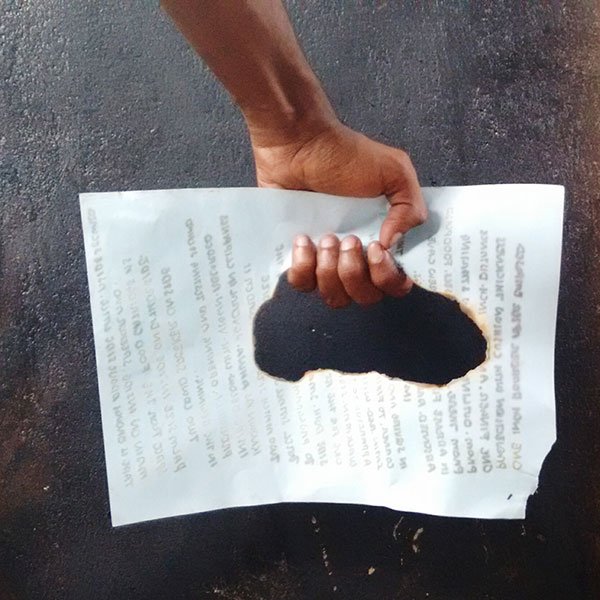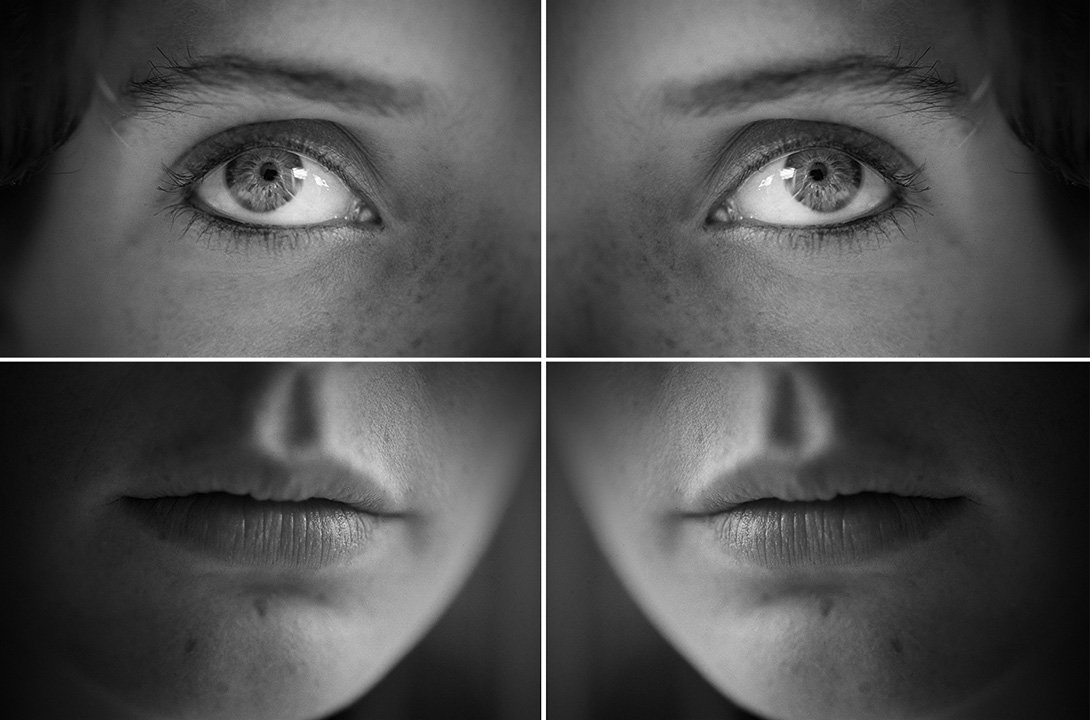Panorama
Photography and Beyond
Photo Mail presents
A panoramic view of
The art of photography’s
Interaction and
Interrelation with other
Art mediums such as literature
Architecture, and
Other visual media
Tulsi Swarna Lakshmi
writes about
Joyel K Pious and
Gaurav Rachamalla’s collaborative
photo project
Photographs
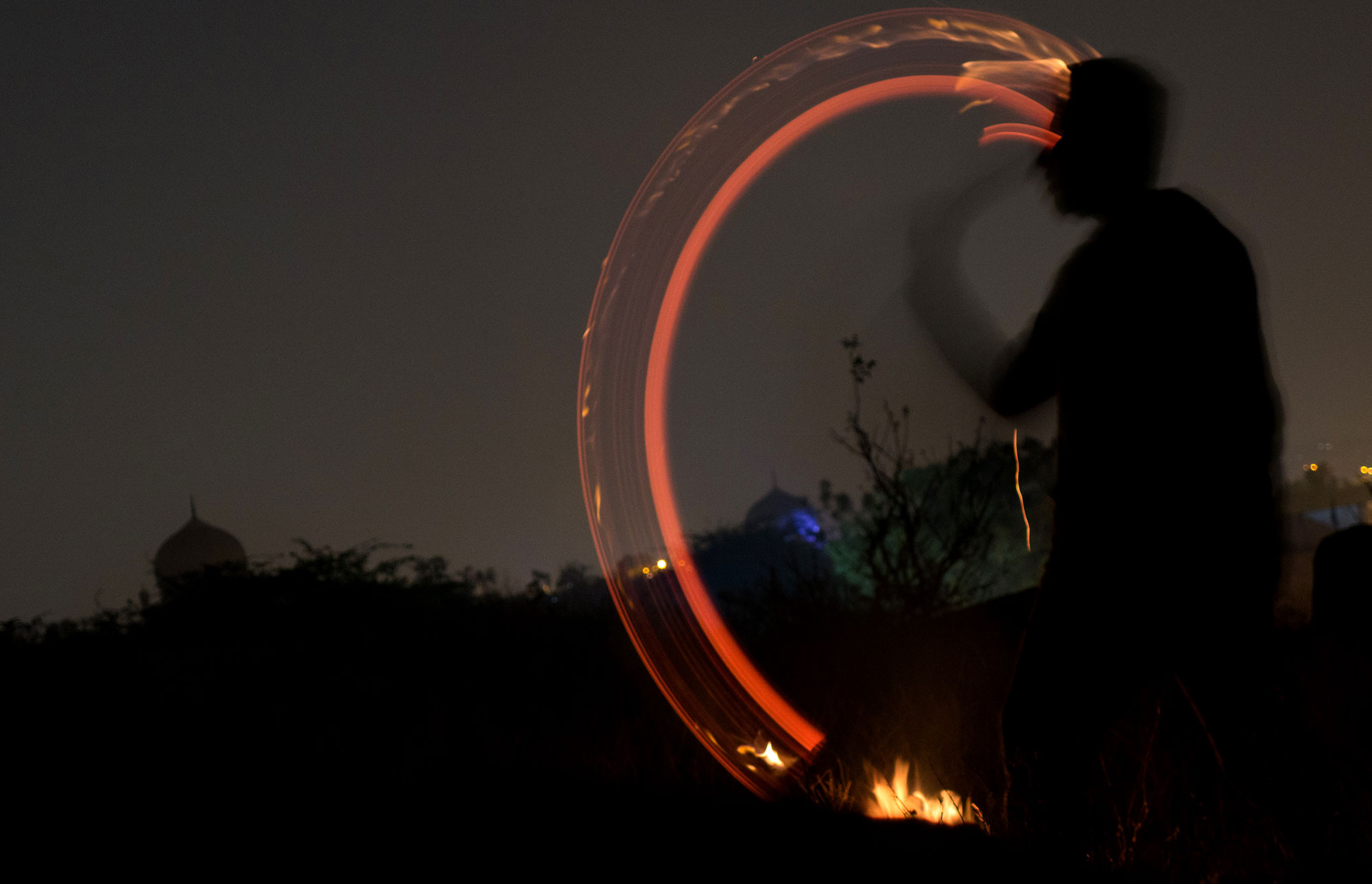
A Sense of Dislocation © Joyel K Pious and Gaurav Rachamalla | 2017
A sense of dislocation
Joyel K Pious and Gaurav Rachamalla’s collaborative photo project
Since its inception, photography has always been available as a means of looking and engaging with external objects and subjects. Its particular relationship with reality, one that is different even from cinema/video, allows it to be flexibly used in collaboration with other processes; in a unique manner not possible through other visual arts. Even the most mundane uses of photographic documentation of performances have greatly affected their reach and preservation post the event. In fact, there is barely any art form, with the exception of music, which has not been fertilized through its engagement with photography. Photography and Beyond seeks to celebrate such collaborations between photography and other media, within an individual’s artistic practice or between multiple individuals. The column will highlight various experiential and technical planes of these undertakings and executions.
– The Editor
Light painting in photography, a technique that traces the effect of time on objects (in motion) through long exposures, shrinking the events across a period into one frame, is not a new idea. It dates back to the late 1880s with Étienne-Jules Marey and Georges Demeny tracing human motion in their famous work called Pathological Walk From in Front. A few years before this, English photographer Eadweard Muybridge had made interesting still sequence of animals in motion, paving the way for photographing objects in motion with precision. Berenice Abbot’s photographic studies of light and motion done during the beginning of the 20th century, contributed much towards the understanding of physical laws and properties of solids and liquids. The long exposure images were shot using strobe lights flashing on an object as it moves through space and time. It was Man Ray who first used the technique in its contemporary sense, as light “painting”, in photographs for the series titled Space Walking, 1935. A few other photographers including American photographer Barbara Morgan had used the technique and in 1949, Pablo Picasso followed suit by making a series of works titled Light Drawings, the most famous one being Picasso draws a Centaur. With the arrival of digital technology and electronics, it became a lot easier to draw using light and many artists in the developed nations had used it innovatively. In March 2007, Jan Leonardo, a German photographer coined the term light art performance photography (LAPP) emphasising the performative aspect of this technique. This term particularly refers to photographs in which abandoned structures, buildings and natural landscape are included in the background. Flashlights, light pen, candles, matches, fireworks, lighter flints, glowsticks and poi are popular sources of light used in such works.
Indian photography hasn’t seen many such explorations that interact and intersect with other media such as light art. But this has started to change in the last couple of years, with a few photographers trying to do light painting; and it is in this context that Joyel K Pious and Gaurav Rachamalla’s collaborative photo project becomes striking. Although this style is popular in the west, this collaborative project stands tall and distinctive amidst the usual Indian street and documentary photographs. It probes the philosophical underpinnings that are intrinsic to the medium itself as well as pose several questions related to urbanisation.
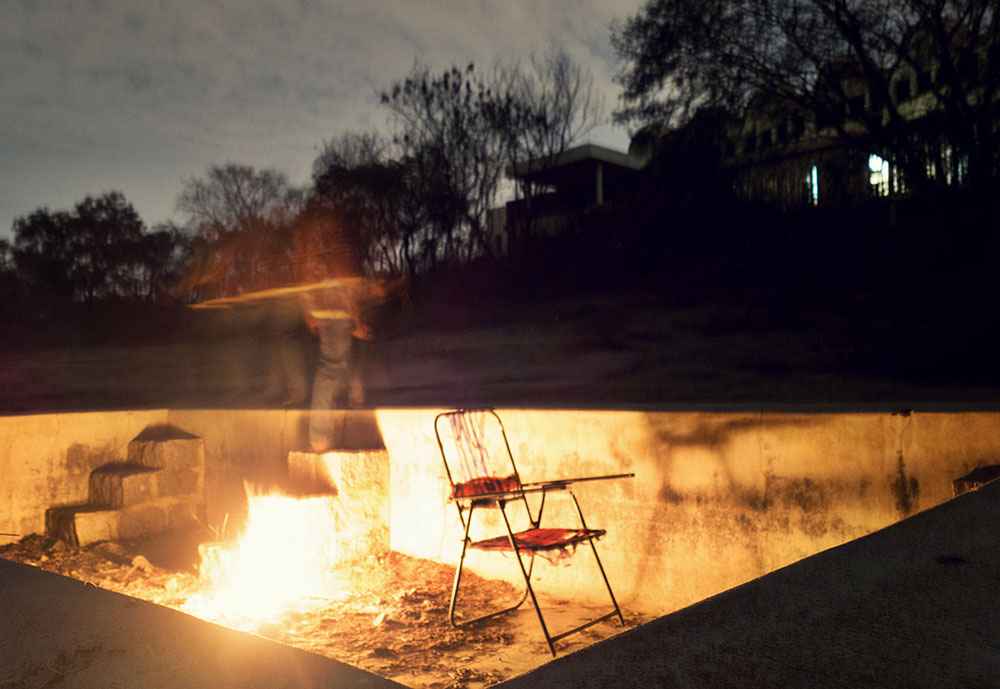
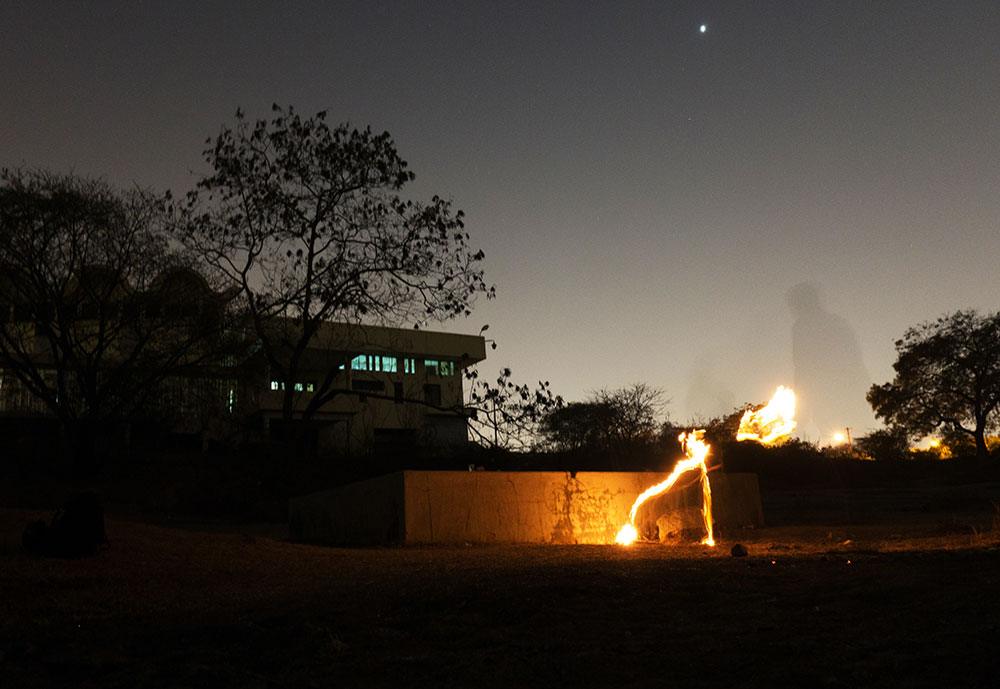
A Sense of Dislocation © Joyel K Pious and Gaurav Rachamalla | 2017
Hunting for places in Hyderabad that at least until now hasn’t surrendered to the relentless urban invasion, the two collaborators seek and identify desolated places and abandoned structures in and around the city’s iconographical buildings such as Maula Ali Dargah, Attarah Seedi near Golconda Fort, Pahadi Shareef Dargah, and the wild outdoors of Osmania University. Archaeologically proven to have been inhabited since the Indian Iron Age that started in 1000 BCE, the region comprising modern Hyderabad and its surroundings were known as Golkonda, literally meaning shepherd’s hill. The modern city of Hyderabad was founded by Muhammad Quli Qutb Shah, the fifth sultan of the Qutb Shahi dynasty of Golkonda in the year 1591. Within a century, the region was captured by the Mughals and the Nizam’s dominions became a princely state during the British Raj. Hyderabad became a center for artists in the mid-19th century with the decline of the Mughal Empire and emerged as one of the important centres of culture in India. Today, it is the sixth most populous urban agglomeration in India, resulting in the erasing of city’s sketchy wilderness. The landmark architectural marvels built during Qutb Shahi and Nizam rule stands in contrast to the burgeoning sky scrapers, diligently preserving memories from a distant past.
Interestingly, the meeting point between Joyel and Gaurav is their own individual interests – Photography and Architecture respectively. The medium of photography offers this possibility of collaboration between different streams, and the point that it is today a dominant form of communication is irrefutable. Most importantly, the changing interaction between architecture and photography, bending in favor of the latter is worth a look. Initially, especially during the colonial documentation, photography was only a technique that documents buildings. It meant that, the role of photography was subservient to that of architecture, which had a greater political, social and artistic value. From being just a means to an end, photography has become a standalone art form with its own aesthetics and expressions, while still being the medium that is most open to interactions with the outside world. Possibly because of the delayed recognition, or the fact that it is now an easy one click application that doesn’t require much effort, most photographers do not consider collaborating with other artists. This is more so in the Indian context, where, by default, stalking the streets all by oneself is preferred to thoughtful creations.
Architecture in photographs have a far greater meaning nowadays. Its position, prominence, focus etc., conveys different connotations and is part of the photographic statement as such. In Joyel and Gaurav’s work, the iconic buildings are the main crux of the narrative, but not so in a direct manner. They do not occupy the central space in the frame, and oftentimes they are excluded, but the vantage points are recognizable to anyone who has truly explored these legendary structures. In the images, the invisible and distant symbols of timeless past pulsate in the background, while the vast sea of lights that represents contemporary buildings is being looked at by a lone figure. Though filling up the larger part of the frame, somehow these buildings become reduced, and even become irrelevant compared to the story that is being narrated, a story of those who belong to the edges, the off beats and the once upon a time shepherds and indigenous people, who lived and loved in nature. Indirectly, it stalks the ever growing population, and their preoccupation for being oblivious to what has been lost and what is at the verge of being lost forever. The humans in the photographs, the one within the frame and the one who is shooting, seem to be the only ones here who are aware of both the existences, of the ironies of development.
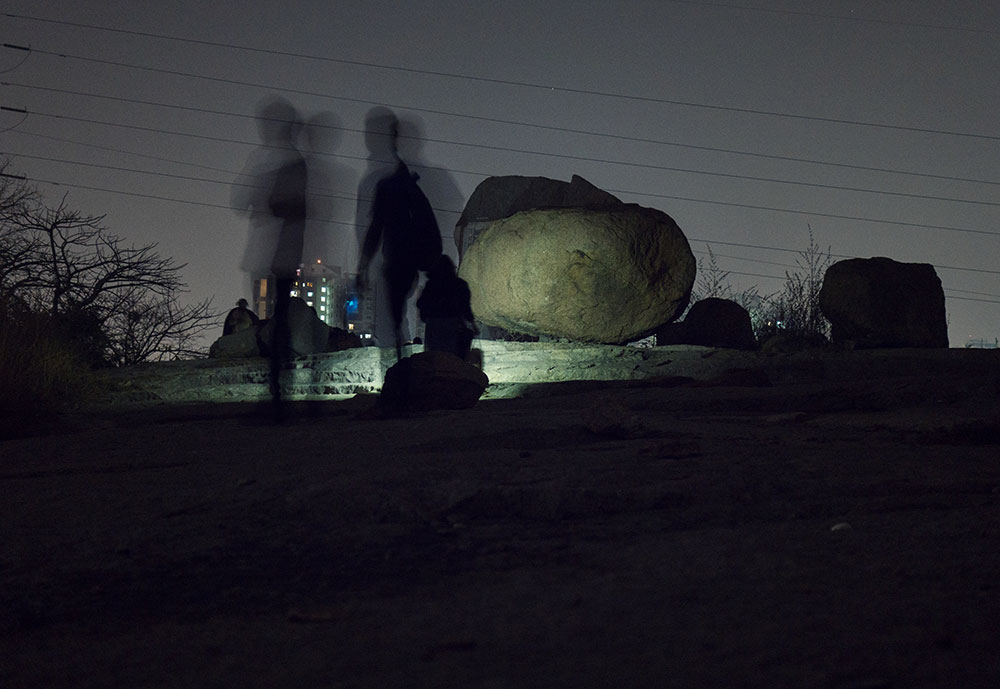
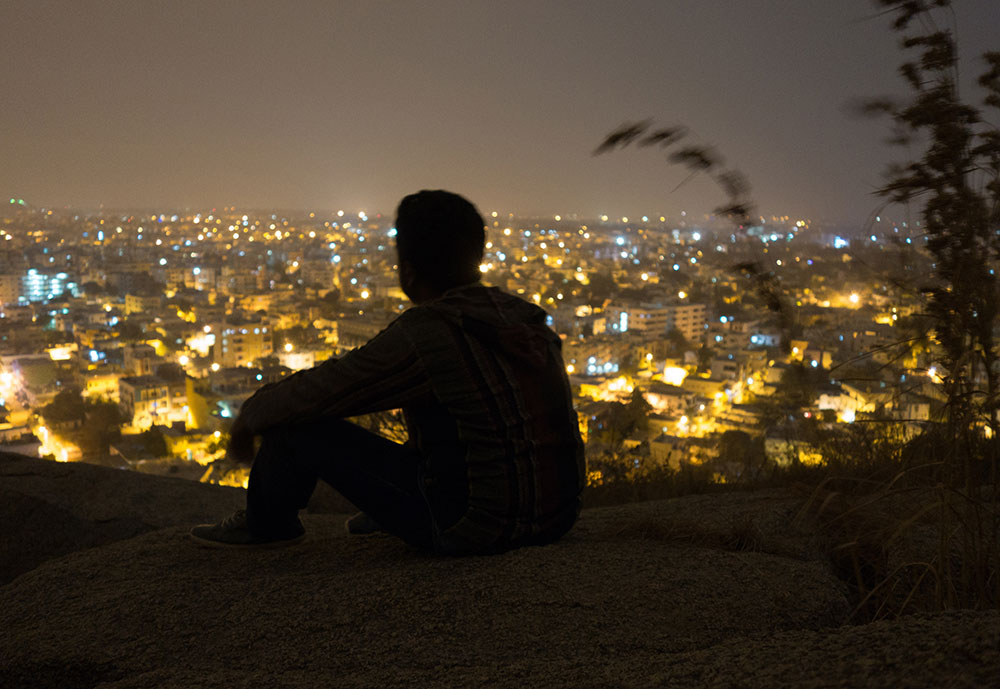
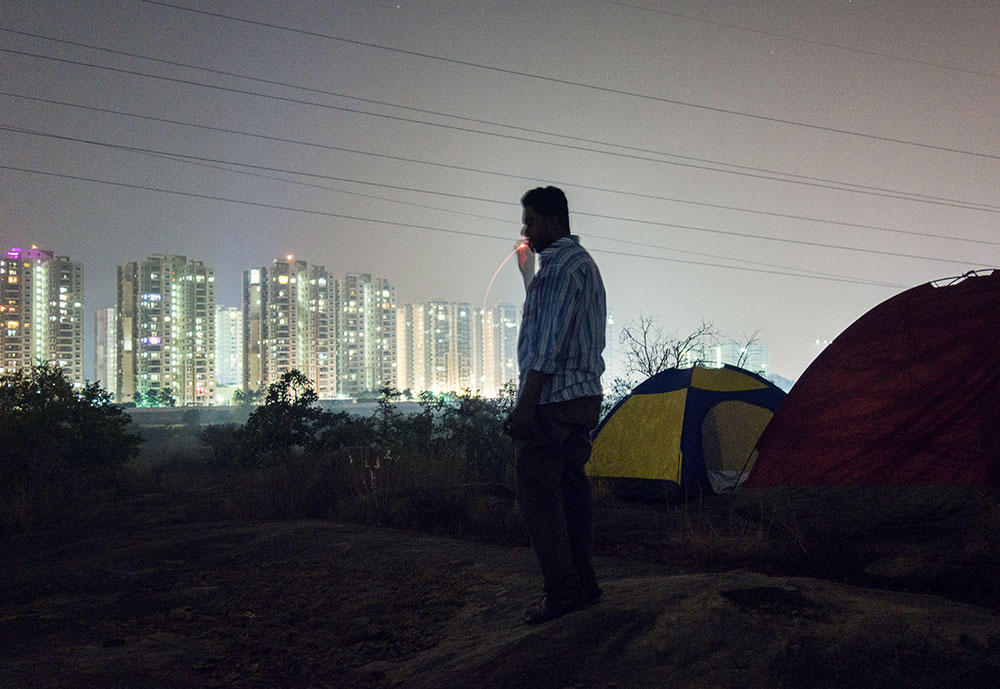
A Sense of Dislocation © Joyel K Pious and Gaurav Rachamalla | 2017
Interestingly titled A Sense of Dislocation, these works have indeed sprung from this deepening sense of dislocation that succeeds in creeping on to the viewer as well – the seamless balance of dazzling movement constructed on purpose in the backdrop of artificiality pops up against the uncanny darkness and effervescent light. The light, artificial and otherwise, in the forefront, becomes the connecting dot for the medium itself, which records electromagnetic radiations of all sorts. On top of being juxtaposed between two extreme realities – one that is a habitation and the other an almost empty space, here, the light becomes a tool to provide a three dimensional appearance, surpassing the limitations of the medium that offers plain and simple two dimensional experience of a multi-dimensional reality. The long exposure, necessitated by the dark ambience, shows what was and what is, bridging the time gap through murky reflections of a presence in its absence, meandering one about the trails left behind.
Here, the trails are not merely these ubiquitous mirages, but of the people and the animals that had dwelled and danced. The duo travels with the shepherds and their animals, who probably stayed at the stone structure that now marks the rear border of the Golconda fort, from where a swathe of thick forests grow west. They would have felt safe and enjoyed the vantage point. And, set a fire, warming up to the tune of the wind. Took a hard look at the Qutub Shahi royals (built from 1543 CE onwards) and talked of ghosts and gods. And, when the time came, they would have left with a nod of gratitude.
It is of the lifestyles of nomadic tribes, who wandered and gathered, and of graveyards that is now home to a remaining few pilgrims and the homeless who consciously or unconsciously continue a tradition that is at its verge of disappearing. It holds in it the dreams of the vagabonds and the fears of the settled. It talks of borders made of invisible lines that divide the world into unidentifiable fragments.
It is of spaces, and of their glory and abandonment. For example, the box near the Osmania University used to be a water tank during rains, an informal performance arena for university’s artists during peak summer, and at odd times, a hub for unknown purposes. When no humans were nearby, the box was usually occupied by peacocks. Now abandoned due to an unfathomable reason, this ruined structure lies exactly at the middle of a thin border which separates modern buildings of this prestigious university from a thick growth of trees. Where have all these artists and the dreamers gone?
It is of the journey of fire, from being a fierce, uncontrollable, wild one that urged the primitive man to invent gods and ghosts, to that of an manipulatable element at service to humans (not always but at least most of the times). And, it is of today’s artificial lights, that illuminates and erases the distinction between night and day. Of losing the circadian rhythm and harmony.
A Sense of Dislocation traces what was and what is, of what has been erased for the now to be emerged, and thus of loss and nostalgia for something that could never be brought back. One is forced to think about the timeless architecture that is in absolute contrast to concrete walls that locks people in. Of the narrowing borderlines of the wilderness that meekly gives way to the ravenous urbanization. Of changing lifestyles and lost dreams. Yet, in that chaos there is perfection, a compromise that bridges our collective past with the present, and focuses on a distant future. For, looking back doesn’t seem to be an option anymore.
Tracing and recollecting that bit of memory from the scents left behind eons ago, the two collaborators attempt to capture the growing feeling of displacement. Thoughtfully, in A Sense of Dislocation, the two artists have used only fire, probably to draw a distinction between the contrasting realities. The light performance is like a ceremonial gathering of sorts and a celebration of the loneliness and the joys of night and fire. It doesn’t have a specific theme but rather than re-enacting an imagined past, they aim to capture the mood of people and places. And the night is the perfect time for catching hold of an emotion that is both melancholic and ghostly. The photographs bear witness to this lonely performance, without which, there would be no evidence whatsoever to what had transpired. The development has succeeded in building walls, between one another, as well as between oneself and nature. Yet there will always be loners and off beats, who would wander into the nights, catching scents and capturing memories.
A Sense of Dislocation is an ode to the changing lifestyles and disappearing nightlife that once celebrated the moon and the stars, and the unlimited skies. As a collaborative project that has a concept and that interacts with other medium, this work stands apart. But what is setting this work apart from the common images of decaying structures, night photography, light painting, etc., is also at this point a limitation. The technical flaws such as the images becoming fuzzy with over exposure, and the conceptual shortcomings such as the angle and placement of the buildings are a disturbance, so to say. In these digital days, achieving perfection is not a tough deal and is a prerequisite. Playfully repeating the frames also means that, at this point, it is trial and error and that the doubts of the beginners have not yet been overcome. It would require a lot more collaboration between the participating artists, practice, as well as an interest and dedication to continue experimenting with the medium.
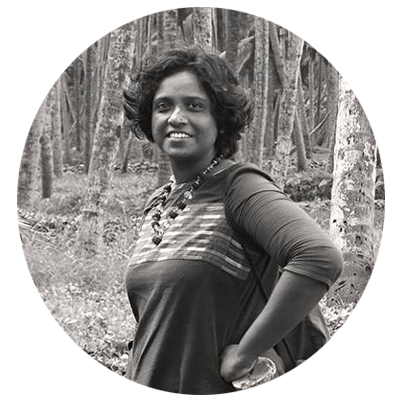
Tulsi Swarna Lakshmi is an independent writer and film-maker. She has more than a decade of experience working with leading National and International Non-Government Organisations in India, Africa, and South America. She is the Founder Managing Trustee of Ekalokam Trust for Photography and the Executive Editor of PhotoMail.
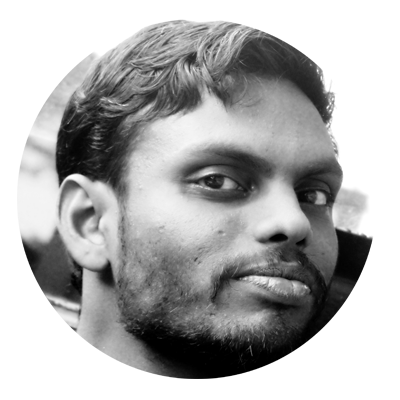
Joyel K Pious is a photographer and bilingual editor. At present he is working as a journalist with The New Indian Express, New Delhi. Joyel also extends his services as the news editor of Photomail. Hailing from Thrissur district in Kerala, he is interested in exploring the interwoven relationship of humans with nature.
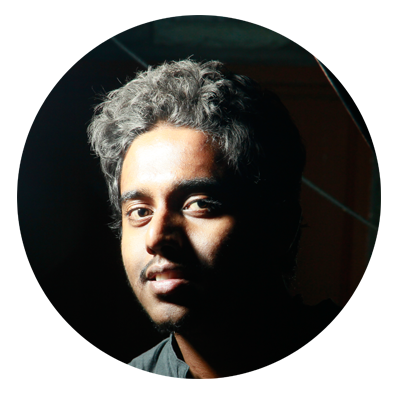
Gaurav Rachamalla is an architect based in Hyderabad. Besides his interest in the architecture of monuments and heritage structures, Gaurav is actively involved in film photography.
Published on September 24, 2018
Share
Related Articles
A Sense of Dislocation
Indian photography hasn’t seen many such explorations that interact and intersect with other media such as light art. But this has started to change in the last couple of years, with a few photographers trying to do light painting; and it is in this context that Joyel K Pious and Gaurav Rachamalla’s collaborative photo project becomes striking. Although this style is popular in the west, this collaborative project stands tall and distinctive amidst the usual Indian street and documentary photographs. It probes the philosophical underpinnings that are intrinsic to the medium itself as well as pose several questions related to urbanisation.
On Ajith Nedumangad’s Photographs
It is the sheer absurdity of the sculptures created and photographed by Ajith that hits the viewer right from the off – juxtapositions (reminiscent of the Dadaists and Surrealists) in which materials and the forms they are used to create are often in conflict with each other and, at other times, are self-referential in a darkly humorous manner.
On Photography, Remembering Susan Sontag
On Susan Sontag, a poem by famous Malayalam-English poet N Ravi Shankar


